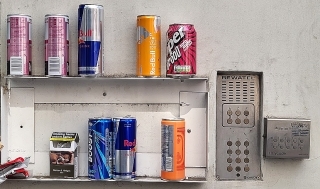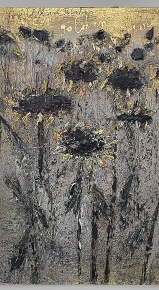Adam Yamey's Blog: YAMEY, page 8
July 22, 2025
A drop in the ocean
Just as many associate Spain with sunshine, plenty of folk think of rain when they consider England. Yet, ironically, there is currently a shortage of water in the country. This is partly because there has been insufficient rainfall and also because for years, governments have neglected maintaining reservoirs and other water sources and water companies have been prioritising profit over provision of water to their customers.
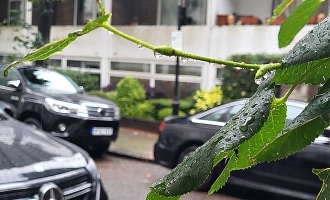
So when it rained today after many weeks of dry weather, we breathed a sigh of relief. But this will be short-lived, because what fell today was literally a drop in the ocean.
July 21, 2025
A rebel at London’s Royal College of Art
THE CARTWRIGHT HALL Art Gallery in Bradford has a collection of paintings by David Hockney (born 1937), some of which he did when he was as young as 16. These early paintings, though not as adventurous as his later work, show that even as a teenager, he was a skilled artist. He studied art at Bradford College of Art. Then, between 1959 and 1962, he continued his studies at London’s Royal College of Art (‘RCA’). It was after his arrival in London that Hockney began experimenting with new ways of expression in painting. Apparently, he was not an ideal student in the eyes of the RCA. For example, he did not attend lectures and did not do the prescribed coursework. Yet, he created numerous paintings that are evidence of his skilful breaking away from conventional painting. Today, we caught the last day of an exhibition of the paintings he did between 1959 and 1963. It was held at Hazlitt Holland-Hibbert Gallery in Mayfair’s Bury Street.
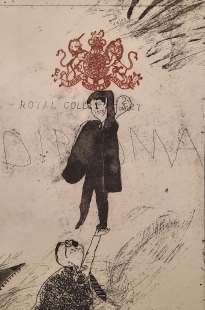 Detail from the Diploma etching
Detail from the Diploma etchingThe gallery’s website explained:
“Exhibited together for the first time, these early paintings embellished with love hearts, graphic text, suggestive shapes and depictions of friends and lovers reveal David Hockney’s precocious talent during the most formative chapter of his career.
In 1959, Hockney moved from Bradford to begin his studies at the Royal College of Art, London, where he was determined to experience the capital’s postwar bohemian culture as well as absorb the modern and contemporary art in its museums and galleries. The exhibition focuses on this period before Hockney relocated to the United States at the end of 1963 and reveals his discovery of an unmistakably personal style of painting that would establish him as the most important artist of his generation.”
It was exciting to view the images he created during this important period of his artistic development. However, for a while the RCA failed to appreciate him, and for a while threatened not to award him his degree. An article in Wikipedia revealed:
“When the RCA said it would not let him graduate if he did not complete an assignment of a life drawing of a live model in 1962, Hockney painted ‘Life Painting for a Diploma’ in protest. He had refused to write an essay required for the final examination and said that he should be assessed solely on his artworks. Recognising his talent and growing reputation, the RCA changed its regulations and awarded him a diploma.”
An etching in the exhibition, “The Diploma”, created in 1962, reflects Hockney’s protestation. Since graduating from the RCA, Hockney has been given awards by many prestigious institutions, and was made a Royal Academician.
Having seen his earliest known works in Bradford, the works done while at the RCA, and later creations, it is easy to understand why Hockney is now regarded as an artist of the highest calibre.
July 20, 2025
Can can
July 19, 2025
Portrayed between lives in a Mayfair art gallery
FRANCESCO CLEMENTE IS an artist born in Naples (Italy) in 1952. Since 1973, he has been visiting India regularly, and has worked there. He has developed a great interest in Asian religions including Hinduism and Buddhism. The 8 paintings in his exhibition, which is showing at the Lévy Gorvy Dayan gallery in Mayfair’s Dover Street until 27 September 2025, are evidence of Clemente’s interest in these belief systems.
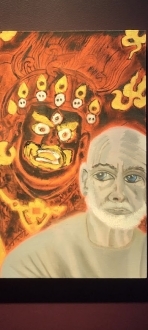
The exhibition is called “Francesco Clemente: Self-Portraits in the Bardo”. The Bardo in the title is a concept of Tibetan Buddhism. It is the state of consciousness during the period between death and rebirth. The artist is depicted in the forefront of each picture. Behind them are fantastic depictions of both the peaceful and the angry deities that are believed to inhabit the Bardo. Whereas Clemente paints himself mainly in shades of grey, the deities are painted in vivid reds, yellows, and black. The artist insisted that the gallery walls be painted purple. This makes these vibrant paintings look even more dramatic.
Hung in a lovely large room with a patterned stucco ceiling, this small exhibition is definitely worth seeing.
July 18, 2025
An artist who loved Gujarat (in western India)
THERE IS A SUPERB collection of modern art from south Asia, which is being exhibited at Phillips auction house in London’s Berkely Square until 31 July 2025. Amongst the artworks on display are several paintings by the late Maqbool Fida Husain. As you can read in the following excerpt from my book about the first journey I made to Gujarat in western India in 2018, the Husain was keen on the area. We were in Ahmedabad when we stumbled across a restaurant called Lucky.
Now read on …
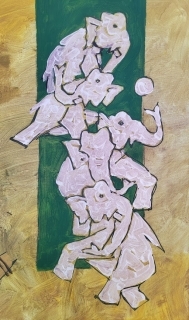
“We ate lunch at Lucky, an unusual restaurant near our hotel. This vegetarian eatery is divided into two sections: one serving sandwiches and Punjabi-style dishes, the other serving mainly south Indian dishes. In one of them, we noticed a framed painting by the famous Indian painter MF Husain (1915-2011), who was born in a Bohri Muslim family in Maharastra. He often travelled to Gujarat to paint. The picture in Lucky, and the place is truly lucky to have it, is a gift which the artist presented in 2004. This was the second original work by Hussain that we had seen in a restaurant. Earlier, we had seen a sketch by him in Bombay’s Noor Mohammadi Hotel, which serves Bohri dishes. When Hussain’s art works began to offend the extremist nationalist sentiments of some Hindus in India and they threatened his life, he felt forced to exile himself. He lived the last few years of his life in the Gulf States and the UK.
The curious thing about Lucky is not the MF Hussain painting, but its location in a disused Muslim cemetery. Its chairs and tables are placed between unmarked Muslim gravestones, painted green and surrounded by low metal railings painted white. The manager thought that these graves were over 300 years old. In addition to the graves, the thick trunk of a tree grows through the middle of the restaurant. The food and service are both good in this busy but peculiar place.”
You can read about my first trip to Gujarat and the two former Portuguese colonies, Daman and Diu, in my paperback book “Travels through Gujarat, Daman, and Diu” (https://www.amazon.co.uk/TRAVELS-THROUGH-GUJARAT-DAMAN-DIU/dp/0244407983) and the kindle version “Travelling through Gujarat, Daman, and Diu” (https://www.amazon.co.uk/TRAVELLING-THROUGH-GUJARAT-DAMAN-DIU-ebook/dp/B07GLWZPHD/)
July 17, 2025
A club where ladies met in Mayfair (London)
NUMBER 35 DOVER Street in London’s Mayfair houses an art gallery on its ground and first floors. The hallway, where a concierge sits behind a desk has four old stained-glass windows, each of them depicting a lady. They look like Pre-Raphaelite images. The marble floor of the lift is inlaid with brass letters, spelling the word ‘Empress’.
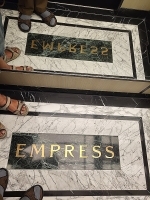
Between 1898 and 1955, number 35 Dover Street was the clubhouse of a women’s club, the Empress Club, which was founded in 1897. It was not the only women’s club in the area (Albemarle Street, Dover Street and Grafton Street), which because of the presence of several clubs for women was known popularly as ‘Petticoat Alley’. A website about the lost clubs of London (https://clubland.substack.com/p/lost-clubs-the-empress-club-1897) has a page detailing the history of the Empress Club. In late Victorian and Edwardian times, it was Mayfair’s leading women’s social club. Its members were mostly from aristocratic families. The feminist activist Princess Sophia Duleep Singh was a member.
The Empress Club began to decline slowly after WW1. During WW2, its members raised money and collected goods for the troops. In 1941, the club was badly damaged during the Blitz. Although attempts were made to revive the club in 1949, it could only stagger on unsteadily. It became a centre for illegal gambling, and was subject to a police raid in 1955. The website noted:
“In 1955, the Club was raided under the Betting Act, and nine men were arrested for illegal gambling on the premises, including popular comedian Tommy Knox of the ‘Crazy Gang’, who was remanded in custody. Knox was bound over to keep the peace, and the Club’s owners, Empress (Berkeley Square) Hotels, were fined £75. In the aftermath of the raid, and a wave of negative publicity portraying the Club in a seedy light, it dissolved later that year, and the building was sold off.”
In 2022, the building, which was designed by the architects John Thomas Wimperis & William Henry Arber, who were best known for building theatres, was completely refurbished. The people responsible for the refurbishment were architectural interior designer Maison Arabella and Orbit Architects. The gallery, which is housed within it is Lévy Gorvy Dayan, which is currently showing an excellent exhibition about which I will write soon.
July 16, 2025
Stark naked and crouching on a pedestal in London’s Mayfair
MY PARENTS HAD a small collection of works of modern art in our home in London’s Hampstead Garden Suburb. These included an engraving by the Italian artist Emilio Greco (1913-1995). I have no idea where this image is now, but having grown up with it I was familiar with the artist’s name even if I knew nothing about him.
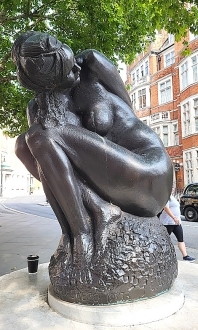
Today (14 July 2025) while walking near the Connaught Hotel in Mayfair, we passed a modern fountain, and close to it, a bronze sculpture of a naked woman, perched on a cylindrical stone pedestal. On the pedestal are carved the words: “A gift to the City of Westminster from the President of the Italian Republic. 20th November 1987. Sponsored by the Italian Bank in London.” The President at that time was Francesco Cossiga (1928-2010). There was no mention of the creator of this artwork on the pedestal. However, at the base of the sculpture I could make out: “Emilio Greco 1977”. It had been made by the artist, whose engraving used to hang on the wall of our living room.
A website (https://pssauk.org/public-sculpture-of-britain/biography/greco-emilio/) provides some information about the artist, and his sculpture in Mayfair, which is a bronze casting of his sculpture “Crouching Figure No. 4”, created in 1973.
The sculpture is a great addition to the area, and is sometimes referred to as ‘Mayfair Lady’!
July 15, 2025
A busy market in a street in west London
CROWDS OF TOURISTS swarm to west London’s Portobello Road Market, especially on weekends. But how many of these visitors from all over the world know anything about the history of the place?
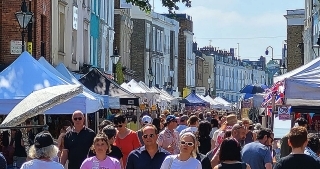
Here is an excerpt from my book “BEYOND MARYLEBONE AND MAYFAIR: EXPLORING WEST LONDON”. Beginning with Kensington and Paddington, it describes London from west of Park Lane and the Edgware Road to (and including) Heathrow Airport, and from Wembley south to Chelsea.
Here is an extract from the chapter dealing with Portobello Road:
“Before the mid-19thcentury Portobello Lane, as it was then called, was to quote the historians Florence Gladstone and Ashley Barker (writing in1924):“‘… one of the most rural and pleasant walks in the summer in the vicinity of London’, and within living memory it led ‘through fields to Kensal Green… cornfields and meadow land on each side… ‘”
Well, Portobello Road is no longer bucolic. It is lined with buildings along its length. Currently, it begins with a short section that leads off Pembridge Villas. It is here that you can stop for a drink at the Sun in Splendour pub, which was built in the early 1850s.Afterrunning a few yards westwards, Portobello Road heads off in a north-westerly direction, which it maintains with barely any deviation for the rest of its length. Number 22 was the first London home of the writer George Orwell. He lived there as a lodger in the winter of 1927. After crossing Chepstow Villas, the road slopes downwards and soon after this the market area commences. On most weekdays, much of the market is dedicated to daily needs, mostly food. On Fridays and Saturdays, the number of stalls and the variety of goods on offer increases dramatically. In normal times (i.e., when there is no pandemic),Portobello Road is choked with crowds of people from all over the world on Saturdays. In the 1860s, the Metropolitan Line (now the ‘Hammersmith and City Line,) was built. It crosses Portobello Road …”
To discover more about London, from west of Park Lane and the Edgware Road to Heathrow Airport, buy a copy of my book/kindle from Amazon website, e.g..:
July 14, 2025
A tailor in Bangalore (India) who knew how to be tactful
My book, “Coracles and Crocodiles: 101 Tales of India”. is an anthology of some of the things I have experienced during three decades of of travelling in India. Here is a short excerpt from it:
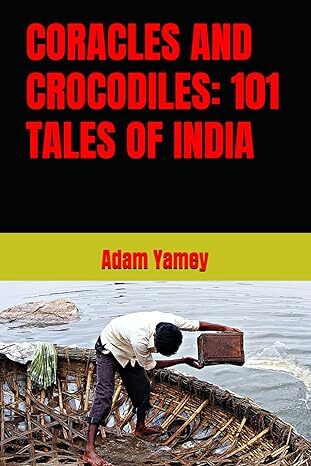
DIPLOMATIC AMNESIA
Almost immediately after I first arrived in India (in late December 1993), and a few days before our Hindu wedding ceremony, my father-in-law recommended that I visit his tailor – Mr Krishnan – to get measured up for some new suits. One of these was to be a white ‘Prince Suit’, and the other two were western style formal suits in greyish materials. The Prince Suit, a traditional Indian design with a high neck collar, was to be worn at our wedding reception after the marriage ceremony. The other garments would be useful for the many formal occasions, which my father-in-law anticipated both in India and England. He loved such occasions.
When he worked in an upmarket tailoring shop in Bangalore’s Brigade Road, Mr Krishnan had made suits for my father-in-law. When I met him, he was semi-retired and worked from his home in a small, old-fashioned house on a short lane in a hollow several feet beneath the nearby busy Queen’s Road. He was a short, elderly gentleman – always very dignified and polite. He measured me up for the suits in his front room, which served as part of his workshop. After a couple of visits to try the suits whilst they were still being worked on, I picked up the finished garments. Each of the suits fitted perfectly – ‘precision-fit’ you could say quite truthfully. Despite being so accurately made, they were not in the least bit uncomfortable. Everybody admired them. I could understand why I had been sent to Mr Krishnan.
Our next trip to India was made 20 months later when our recently born daughter had had sufficient vaccinations to allow her to travel safely. During the interval between these two holidays, my dimensions had changed significantly because of my good appetite and happy marriage. Notably, my girth had increased greatly. Sadly, the suits that Mr Krishnan had so carefully crafted no longer fitted me.
We returned to see Mr Krishnan, who told us that in anticipation of my dimensions changing, he had left extra cloth within the garments for adjusting them. Without comment, he took my new measurements, and noted them down in a book. My wife, who had accompanied me, said to the tailor, mischievously:
“Just out of curiosity, Mr Krishnan, would you be able to look up Adam’s previous measurements to see how much he has changed.”
He put down his pencil, sighed, and said:
“I am very sorry, Madame, but I have unfortunately lost them.”
Mr Krishnan was not only a wonderful tailor, but also a perfect diplomat.
End of excerpt
You can enjoy more tales like this, and experience India without leaving home by buying a copy of the book from Amazon websites, e.g.:
https://www.amazon.co.uk/CORACLES-CROCODILES-101-TALES-INDIA/dp/B0DJZ6DMYB/

